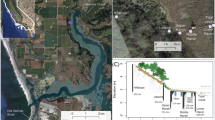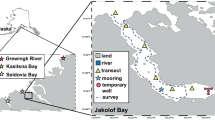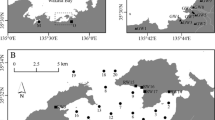Abstract
Low-relief environments like the Florida Coastal Everglades (FCE) have complicated hydrologic systems where surface water and groundwater processes are intimately linked yet hard to separate. Fluid exchange within these low-hydraulic-gradient systems can occur across broad spatial and temporal scales, with variable contributions to material transport and transformation. Identifying and assessing the scales at which these processes operate is essential for accurate evaluations of how these systems contribute to global biogeochemical cycles. The distribution of 222Rn and 223,224,226Ra have complex spatial patterns along the Shark River Slough estuary (SRSE), Everglades, FL. High-resolution time-series measurements of 222Rn activity, salinity, and water level were used to quantify processes affecting radon fluxes out of the mangrove forest over a tidal cycle. Based on field data, tidal pumping through an extensive network of crab burrows in the lower FCE provides the best explanation for the high radon and fluid fluxes. Burrows are irrigated during rising tides when radon and other dissolved constituents are released from the mangrove soil. Flushing efficiency of the burrows—defined as the tidal volume divided by the volume of burrows—estimated for the creek drainage area vary seasonally from 25 (wet season) to 100 % (dry season) in this study. The tidal pumping of the mangrove forest soil acts as a significant vector for exchange between the forest and the estuary. Processes that enhance exchange of O2 and other materials across the sediment-water interface could have a profound impact on the environmental response to larger scale processes such as sea level rise and climate change. Compounding the material budgets of the SRSE are additional inputs from groundwater from the Biscayne Aquifer, which were identified using radium isotopes. Quantification of the deep groundwater component is not obtainable, but isotopic data suggest a more prevalent signal in the dry season. These findings highlight the important role that both tidal- and seasonal-scale forcings play on groundwater movement in low-gradient hydrologic systems.







Similar content being viewed by others
References
Anderson, M.S., V.N.R. Jakobsen, and D. Postma. 2005. Geochemical processes and solute transport at the seawater/freshwater interface of a sandy aquifer. Geochimica et Cosmochimica Acta 69: 3979–3994.
Badon-Ghyben, W. 1889. Nota in verband met de voorgenomen put boring nabij Amsterdam (notes on the probable results of the proposed well drilling near Amsterdam). Koninkl. Inst. Ing. Tijdschr, 1888-89, The Hague: 21.
Balentine, K.M., G. Tiling, and T.J. Smith III (eds.). 2008. Overview of USGS Coastal and Marine Geology Program data management and analysis tools for geologic and hazards information [abs.], USGS Gulf Coast Science Conference and Florida Integrated Science Center Meeting: Proceedings with abstracts, October 20-23, 2008, 2008–1329. Orlando: U.S. Geological Survey Open-File Report. 96 pp.
Bergamaschi, B.A., D.P. Krabbenhoft, G.R. Aiken, E. Patino, D.G. Rumbold, and W.H. Orem. 2011. Tidally driven export of dissolved organic carbon, total mercury, and methylmercury from a mangrove-dominated estuary. Environmental Science & Technology 46: 1371–1378.
Berner, R.A. 1980. Early diagenesis: a theoretical approach. Princeton: Princeton University Press. 241 pp.
Boto, K.G., and J.S. Bunt. 1981. Tidal export of particulate organic matter from a Northern Australian mangrove system. Estuarine, Coastal and Shelf Science 13: 247–255.
Breithaupt, J.L., J.M. Smoak, T.J. Smith, C.J. Sanders and A. Hoare. 2012. Organic carbon burial rates in mangrove sediments: Strengthening the global budget. Global Biogeochemical Cycles GB3011, doi:10.1029/2012gb004375.
Burnett, W.C., G. Kim, and D. Lane-Smith. 2001. A continuous monitor for assessment of Rn-222 in the coastal ocean. Journal of Radioanalytical and Nuclear Chemistry 249: 167–172.
Burnett, W.C., P.K. Aggarwal, A. Aureli, H. Bokuniewicz, J.E. Cable, M.A. Charette, E. Kontar, S. Krupa, K.M. Kulkarni, A. Loveless, W.S. Moore, J.A. Oberdorfer, J. Oliveira, N. Ozyurt, P. Povinec, A.M.G. Privitera, R. Rajar, R.T. Ramassur, J. Scholten, T. Stieglitz, M. Taniguchi, and J.V. Turner. 2006. Quantifying submarine groundwater discharge in the coastal zone via multiple methods. Science of the Total Environment 367: 498–543.
Burnett, W.C., I.R. Santos, Y. Weinstein, P.W. Swarzenski, and B. Herut. 2007. Remaining uncertainties in the use of Rn-222 as a quantitative tracer of submarine groundwater discharge. In A New Focus on Groundwater-Seawater Interactions, ed. W. Sanford, C. Langevin, M. Polemio, and P. Povinec, 125–133. Perugia: IAHS Publ.
Cooper, H.H. 1959. A hypothesis concerning the dynamic balance of fresh water and salt water in a coastal aquifer. Journal of Geophysical Research 64: 461–467.
Crusius, J., D. Koopmans, J.F. Bratton, M.A. Charette, K. Kroeger, P. Henderson, L. Ryckman, K. Halloran, and J.A. Colman. 2005. Submarine groundwater discharge to a small estuary estimated from radon and salinity measurements and a box model. Biogeosciences 2: 141–157.
Dittmar, T., and R.J. Lara. 2001. Driving forces behind nutrient and organic matter dynamics in a mangrove tidal creek in north Brazil. Estuarine, Coastal and Shelf Science 52: 249–259.
Dittmar, T., N. Hertkorn, G. Kattner and R.J. Lara. 2006. Mangroves, a major source of dissolved organic carbon to the oceans. Global Biogeochemical Cycles GB1012, doi:10.1029/2005gb002570.
Duever, M.J., J.F. Meeder, L.C. Meeder, and J.M. McCollom. 1994. The climate of South Florida and its role in shaping the Everglades ecosystem. Everglades--the ecosystem and its restoration: Delray Beach, 225–248. Florida: St. Lucie Press.
Dulaiova, H., R. Peterson, W.C. Burnett, and D. Lane-Smith. 2005. A multi-detector continuous monitor for assessment of Rn-222 in the coastal ocean. Journal of Radioanalytical and Nuclear Chemistry 263: 361–365.
Gardner, L.R., and E.F. Gaines. 2008. A method for estimating pore water drainage from marsh soils using rainfall and well records. Estuarine, Coastal and Shelf Science 79: 51–58.
Gleeson, J., I.R. Santos, D.T. Maher, and L. Golsby-Smith. 2013. Groundwater-surface water exchange in a mangrove tidal creek: Evidence from natural geochemical tracers and implications for nutrient budgets. Marine Chemistry. doi:10.1016/j.marchem.2013.02.001.
Gonneea, M.E., P.J. Morris, H. Dulaiova, and M.A. Charette. 2008. New perspectives on radium behavior within a subterranean estuary. Marine Chemistry 109: 250–267.
Hemond, H.F., and J.L. Fifield. 1982. Subsurface flow in salt marsh peat: a model and field study. Limnology and Oceanography 27: 126–136.
Kim, G., and P.W. Swarzenski. 2010. Submarine groundwater discharge (SGD) and associated nutrient fluxes to the coastal ocean. In Carbon and nutrient fluxes in continental margins, ed. K.-K. Liu, L. Atkinson, R. Quiñones, and L. Talaue-McManus, 529–538. Heidelberg: Springer Berlin.
Kim, G., W.C. Burnett, H. Dulaiova, P.W. Swarzenski, and W.S. Moore. 2001. Measurement of 224Ra and 226Ra activities in natural waters using a radon-in-air monitor. Environmental Science & Technology 35: 4680–4683.
Klerks, P.L., D.L. Felder, K. Strasser, and P.W. Swarzenski. 2007. Effects of ghost shrimp on zinc and cadmium in sediments from Tampa Bay, FL. Marine Chemistry 104: 17–26.
Koretsky, C.M., C. Meile, and P. Van Cappellen. 2002. Quantifying bioirrigation using ecological parameters: a stochastic approach. Geochemical Transactions 3: 17–30.
Li, Y.-H., and L.-H. Chan. 1979. Desorption of Ba and 226Ra from river-borne sediments in the Hudson estuary. Earth and Planetary Science Letters 43: 343–350.
Maher, D.T., I.R. Santos, L. Golsby-Smith, J. Gleeson, and B.D. Eyre. 2013. Groundwater-derived dissolved inorganic and organic carbon exports from a mangrove tidal creek: The missing mangrove carbon sink? Limnology and Oceanography 58: 475–488.
Martens, C.S., G.W. Kipphut, and J.V. Klump. 1980. Sediment-water chemical exchange in the coastal zone traced by in situ radon-222 flux measurements. Science 208: 285–288.
Martin, J.B., J.E. Cable, C. Smith, M. Roy, and J. Cherrier. 2007. Magnitudes of submarine groundwater discharge from marine and terrestrial sources: Indian River Lagoon. Florida: Water Resources Research W05440. doi:10.1029/2006WR005266.
Meile, C., and P. Van Cappellen. 2003. Global estimates of enhanced solute transport in marine sediments. Limnology and Oceanography 48: 777–786.
Meysman, F.J.R., E.S. Galaktionov, B. Gribsholt, and J.J. Middelburg. 2006. Bioirrigation in permeable sediments: advective pore-water transport induced by burrow ventilation. Limnology and Oceanography 51: 142–156.
Michael, H.A., A.E. Mulligan, and C.F. Harvey. 2005. Seasonal oscillations in water exchange between aquifers and the coastal ocean. Nature 436: 1145–1148.
Michael, H.A., M.A. Charette, and C.F. Harvey. 2011. Patterns and variability of groundwater flow and radium activity at the coast: a case study from Waquoit Bay, Massachusetts. Marine Chemistry 127: 100–114.
Moore, W.S. 1999. The subterranean estuary: A reaction zone of ground water and sea water. Marine Chemistry 65: 111–125.
Moore, W.S., and R. Arnold. 1996. Measurement of Ra-223 and Ra-224 in coastal waters using a delayed coincidence counter. Journal of Geophysical Research, Oceans 101: 1321–1329.
Moore, W.S., and D.F. Reid. 1973. Extraction of radium from natural-waters using manganese-impregnated acrylic fibers. Journal of Geophysical Research 78: 8880–8886.
Parker, G.G., N.D. Hoy and M.C. Schroeder. 1955. Geology. In Water resources of Southeastern Florida with Special Reference to Geology and Groundwater of the Miami Areas, eds. G.G. Parker, G.E. Gerguson, A.J. Love and et al, 1255, 57–125. USGS Water Supply Paper.
Peterson, R.N., I.R. Santos, and W.C. Burnett. 2009. Evaluating groundwater discharge to tidal rivers based on a Rn-222 time-series approach. Estuarine, Coastal and Shelf Science 86: 165–178.
Price, R.M., Z. Top, J.D. Happell, and P.K. Swart. 2003. Use of tritium and helium to define groundwater flow conditions in Everglades National Park. Water Resources Research 39:1267. doi:10.1029/2002WR001929.
Price, R.M., P.K. Swart, and J.W. Fourqurean. 2006. Coastal groundwater discharge - an additional source of phosphorus for the oligotrophic wetlands of the Everglades. Hydrobiologia 569: 23–36.
Rama, and W.S. Moore. 1996. Using the radium quartet for evaluating groundwater input and water exchange in salt marshes. Geochimica et Cosmochimica Acta 60: 4645–4652.
Robinson, C., L. Li, and D.A. Barry. 2007. Effect of tidal forcing on a subterranean estuary. Advances in Water Resources 30: 851–865.
Rodellas, V., J. Garcia-Orellana, P. Masque, and J.S. Font-Munoz. 2015. The influence of sediment sources on radium-derived estimates of Submarine Groundwater Discharge. Marine Chemistry 171: 107–117.
Roy, M., J.B. Martin, J. Cherrier, J.E. Cable, and C.G. Smith. 2010. Influence of sea level rise on iron diagenesis in an east Florida subterranean estuary. Geochimica et Cosmochimica Acta 74: 5560–5573.
Saha, A.K., C.S. Moses, R.M. Price, V. Engel, T.J. Smith Iii and G. Anderson. 2011. A hydrological budget (2002-2008) for a large subtropical wetland ecosystem indicates marine groundwater discharge accompanies diminished freshwater flow. Estuaries and Coasts. doi:10.1007/s12237-011-9454-y.
Santos, I.R., R.N. Peterson, B.D. Eyre, and W.C. Burnett. 2010. Significant lateral inputs of fresh groundwater into a stratified tropical estuary: evidence from radon and radium isotopes. Marine Chemistry 121: 37–48.
Santos, I.R., B.D. Eyre, and M. Huettel. 2012. The driving forces of porewater and groundwater flow in permeable coastal sediments: a review. Estuarine, Coastal and Shelf Science 98: 1–15.
Schubert, M., A. Paschke, E. Lieberman, and W.C. Burnett. 2012. Air-water partitioning of Rn-222 and its dependence on water temperature and salinity. Environmental Science & Technology 46: 3905–3911.
Smith, C.G., and P.W. Swarzenski. 2012. An investigation of submarine groundwater-borne nutrient fluxes to the west Florida shelf and recurrent harmful algal blooms. Limnology and Oceanography 57: 471–485.
Smith III, T.J., K.G. Boto, S.D. Frusher, and R.L. Giddins. 1991. Keystone species and mangrove forest dynamics: the influence of burrowing by crabs on soil nutrient status and forest productivity. Estuarine, Coastal and Shelf Science 33: 419–432.
Smith, C.G., J.E. Cable, and J.B. Martin. 2008. Episodic high-intensity mixing events in a subterranean estuary: Effects of tropical cyclones. Limnology and Oceanography 53: 666–674.
Spence, V. 2011. Estimating groundwater discharge in the oligohaline ecotone of the Everglades using temperature as a tracer and variable-density groundwater models. Masters Thesis, Department of Geology, University of South Florida, 36 pp.
Stieglitz, T., P. Ridd, and P. Müller. 2000. Passive irrigation and functional morphology of crustacean burrows in a tropical mangrove swamp. Hydrobiologia 421: 69–76.
Stieglitz, T.C., J.F. Clark, and G.J. Hancock. 2013. The mangrove pump: the tidal flushing of animal burrows in a tropical mangrove forest determined from radionuclide budgets. Geochimica et Cosmochimica Acta 102: 12–22.
Swarzenski, P.W. 2007. U/th series radionuclides as coastal groundwater tracers. Chemical Reviews 107: 663–674.
Swarzenski, P.W., F.W. Simonds, T. Paulson, S. Kruse, and C. Reich. 2007. A geochemical and geophysical examination of submarine groundwater discharge and associated nutrient loading estimates into Lynch Cove, Hood Canal, WA. Environmental Science & Technology. doi:10.1021/es070881a.
Troxler, T.G., J.G. Barr, J.D. Fuentes, V. Engel, G. Anderson, C. Sanchez, D. Lagomasino, R. Price, and S.E. Davis. 2015. Component-specific dynamics of riverine mangrove CO2 efflux in the Florida Coastal Everglades. Agricultural and Forest Meteorology. doi:10.1016/j.agrformet.2014.12.012.
Wdowinski, S., S.H. Hong, A. Mulcan, and B. Brisco. 2013. Remote-sensing monitoring of tide propagation through coastal wetlands. Oceanography 26: 64–69.
Webster, I.T., G.J. Hancock, and A.S. Murray. 1994. Use of radium isotopes to examine pore-water exchange in an estuary. Limnology and Oceanography 39: 1917–1927.
Webster, I.T., G.J. Hancock, and A.S. Murray. 1995. Modelling the effect of salinity on radium desorption from sediments. Geochimica et Cosmochimica Acta 59: 2469–2476.
Whelan, K.R.T., T.J. Smith III, D.R. Cahoon, J.C. Lynch, and G.H. Anderson. 2005. Groundwater control of mangrove surface elevation: Shrink and swell varies with soil depth. Estuaries 28: 833–843.
Wilson, A.M., and L.R. Gardner. 2006. Tidally driven groundwater flow and solute exchange in a marsh: Numerical simulations. Water Resources Research 42: W01405. doi:10.1029/2005WR004302.
Wingard, G.L., C.A. Budet, R.E. Ortiz, J. Hudley, and J.B. Murray. 2006. Descriptions and preliminary report on sediment cores from the southwest coastal area, part II: Collected July 2005, Everglades National Park, Florida, Open-file report 2006-1271. Reston: U.S. Geological Survey.
Xin, P., G. Jin, L. Li, and D.A. Barry. 2009. Effects of crab burrows on pore water flows in salt marshes. Advances in Water Resources 32: 439–449.
Xin, P., L. Li, and D.A. Barry. 2013. Tidal influence on soil conditions in an intertidal creek-marsh system. Water Resources Research 49: 137–150.
Younger, P.L. 1996. Submarine groundwater discharge. Nature 382: 121–122.
Acknowledgments
This material is based upon work supported by the National Science Foundation through the Florida Coastal Everglades Long-Term Ecological Research program under Grant Nos. DBI-0620409 and DEB-1237517. This is SERC contribution number 774. The authors would like to thank T.J. Smith, III and Gordon Anderson for access to groundwater wells along the Shark River Slough as well as Jordon Sanford and Lance Thornton for their help in the field. We would also like to think Lisa Robbins and two anonymous reviews for providing constructive feedback that greatly improved the quality of this manuscript. Finally, we would like to thank Victor Engel (formerly of the National Park Service) and the National Park Service for access to the Florida Coastal Everglades. The authors CGS and PWS would like to thank the USGS Coastal and Marine Geology Program for continued support. Any use of trade, product, or firm names is for descriptive purposes only and does not imply endorsement by the US government.
Author information
Authors and Affiliations
Corresponding author
Additional information
Communicated by Isaac Santos
Electronic supplementary materials
Below is the link to the electronic supplementary material.
ESM 1
(DOCX 579 kb)
Rights and permissions
About this article
Cite this article
Smith, C.G., Price, R.M., Swarzenski, P.W. et al. The Role of Ocean Tides on Groundwater-Surface Water Exchange in a Mangrove-Dominated Estuary: Shark River Slough, Florida Coastal Everglades, USA. Estuaries and Coasts 39, 1600–1616 (2016). https://doi.org/10.1007/s12237-016-0079-z
Received:
Revised:
Accepted:
Published:
Issue Date:
DOI: https://doi.org/10.1007/s12237-016-0079-z




